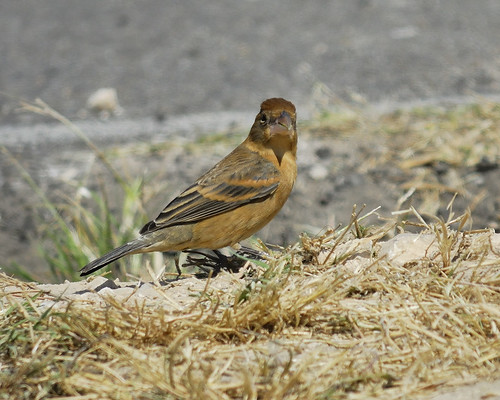tags: Blue Grosbeak, Passerina caerulea, Guiraca caerulea, birds, mystery bird, bird ID quiz
[Mystery bird] Female Blue Grosbeak, Passerina (Guiraca) caerulea, photographed at Quintana Neotropical Bird Sanctuary, Brazoria County, Texas. [I will identify this bird for you in 48 hours] [For your reference, here's a male of the species in breeding plumage]
Image: Joseph Kennedy, 27 April 2010 [larger view].
Nikon D200, Kowa 883 telescope with TSN-PZ camera eyepiece 1/750s f/8.0 at 1000.0mm iso400.
Please name at least one field mark that supports your identification.
- Log in to post comments
More like this
tags: Indigo Bunting, Passerina cyanea, Guiraca cyanea, birds, mystery bird, bird ID quiz
[Mystery bird] Adult female Indigo Bunting, Passerina (Guiraca) cyanea, photographed at Quintana Neotropical Bird Sanctuary, Brazoria County, Texas. [I will identify this bird for you in 48 hours]
Image:…
tags: Whimbrel, Numenius phaeopus, birds, mystery bird, bird ID quiz
[Mystery bird] Whimbrel, Numenius phaeopus, photographed at Quintana Neotropical Bird Sanctuary, Brazoria County, Texas. [I will identify this bird for you in 48 hours]
Image: Joseph Kennedy, 27 April 2010 [larger view].
Nikon…
tags: Indigo Bunting, Passerina cyanea, Guiraca cyanea, birds, mystery bird, bird ID quiz
[Mystery bird] Adult male Indigo Bunting, Passerina (Guiraca) cyanea, photographed at Quintana Neotropical Bird Sanctuary, Brazoria County, Texas. [I will identify this bird for you in 48 hours]
Image:…
tags: Painted Bunting, Rainbow Bunting, Passerina ciris, birds, mystery bird, bird ID quiz
[Mystery bird] Painted Bunting, also known as the Rainbow Bunting, Passerina ciris, photographed at Quintana Neotropical Bird Sanctuary, Brazoria County, Texas. [I will identify this bird for you in 48…


Got it! A common bird in my area, though ours are always very near the water. The tawny underparts and wingbars, along with that humongous bill are good marks. A strangely named bird, given this plumage.
This is a tough one (for me, anyway). I'm trying to get a handle on the beak and the tail. I want the beak to be big and seedy. And I want the tail to be longer, but maybe it is longer and it's the photo angle?
Which is to say, I'm thinking a first year not brown bird with a heavy beak. Or a female not brown bunting? (The photo seems less chunky than I think of buntings, though.)
Even with the larger picture it is hard to see but I think I can see the unusual geometry of the bill. Head seems very large and I think I can see the notched tail. Sibley's has an illustration of a variant with narrow wing bars, which would differentiate it from the other member of the genus.
A little OT - but I jJust wanted to share this with someone who might enjoy the vision. Never seen this described before, or observed it, not even after having lived for several years sharing homesite with Kingfishers.
I observed a pair of Puget Sound Kingfishers doing something rather remarkable the other day. They were in the midst of courtship, flying at high speed to and fro across the harbor. At one point they rested on top of a Ferry Dolphin, about 15' above water level, then they left that a did what I can only describe as a falling leaf maneuver - they took up relative positions face to face, beaks alongside each other, and fell slowly at the same time rotating about a vertical axis while maintaining their face-to-face posture, obviously totally immersed in each other and paying no attention to where they were headed. I'm not even sure they were flapping their wings, I think not. They only ended this when they splashed into the water, at which point they gave a little start and took off.
Anyone else know of it?.